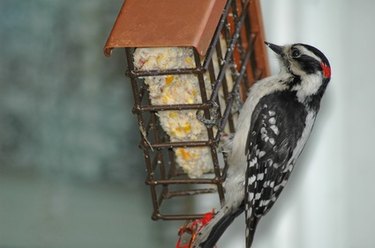
Snapdragons are beautiful, self-seeding annuals that get their name from the interesting shape of their flower. They come in dozens of varieties, giving gardeners a wide range of choices in terms of plant size and flower color. However, these attractive plants look like lunch to bugs and other critters. This quickly can ruin a snapdragon set, so it's important to identify what's munching on the plants before the problem worsens and spreads.
Insects and Pests
Video of the Day
The University of Florida provides a lengthy list of insects and pests that are problematic for snapdragons. These include mites (e.g., spider, cyclamen), beet armyworms, the American serpentine leafminer, corn earworm, pill bugs, slugs, snails, aphids, thrips and tobacco budworms.
Video of the Day
Fungi, Molds and Viruses
Although insects and pests usually cause the most damage to snapdragons, fungi molds and viruses also may be problematic. Since some fungi, molds and viruses cause spotting or leaf degeneration that gives the impression that something has been feasting on the snapdragon plant, you shouldn't rule out the possibility that the problem might be something other than an insect or pest. Common fungi, molds and viruses that affect snapdragons, according to the University of Florida, include Botrytis cineraria (gray mold), Oidium sp. (powdery mildew), Peronospora antirrhini (downy mildew); Phyllosticta antirrhini (leafspot) and Rhizoctonia solani (root and stem rot).
Animals and Birds
Very, very few animals will eat snapdragons, as, according to Easybalconygardening.com, they are toxic. In fact, gardeners often use snapdragons around their garden perimeters to repel deer and other wildlife. You probably can rule out the possibility that an animal is the culprit. However, birds are another story. Cliff swallows and woodpeckers both have been known to eat snapdragons.
Treatment
For most insects, pests, fungi and viruses, you'll need to treat your snapdragons with an insecticide or fungicide. However, avoid those that are full of harsh chemicals--instead, go organic, as these are much easier on the plants. Examples include soaps designed especially for plants, plant-based insecticides like nicotine or pyrethrum, and homemade sprays of water, alcohol, lemon juice or vinegar. These work by disinfecting, breaking down the cells of the pest, or naturally repelling the pest through scent. Repotting and watching soil pH can get rid of pests that invade the soil, and stiff copper netting or dichotomous earth may keep snails and slugs from being able to climb up the plant. If birds are the problem, devices are available that emit sound waves audible to the birds--the birds don't like all the noise, so they stay away.
Spacing
No matter what is eating your snapdragons, once you find a problem, thinning the plants or spacing them further apart may keep the issue from jumping from plant to plant. Since snapdragons are annuals anyway, you won't need to worry about ruining the entire garden with this method, since you can resow in the spring to fill in gaps. It's always better to lose a few snapdragons than the entire bed.